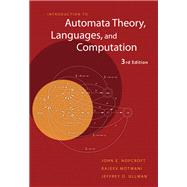
Note: Supplemental materials are not guaranteed with Rental or Used book purchases.
Purchase Benefits
Looking to rent a book? Rent Introduction to Automata Theory, Languages, and Computation [ISBN: 9780321455369] for the semester, quarter, and short term or search our site for other textbooks by Hopcroft, John E.. Renting a textbook can save you up to 90% from the cost of buying.
| Automata: The Methods and the Madness | |
| Why Study Automata Theory | |
| Introduction to Formal Proof | |
| Additional Forms of Proof | |
| Inductive Proofs | |
| The Central Concepts of Automata Theory | |
| Summary of Chapter 1 | |
| Gradiance Problems for Chapter 1 | |
| References for Chapter 1 | |
| Finite Automata | |
| An Informal Picture of Finite Automata | |
| Deterministic Finite Automata | |
| Nondeterministic Finite Automata | |
| An Application_ Text Search | |
| Finite Automata With EpsilonTransitions | |
| Summary of Chapter 2 | |
| Gradiance Problems for Chapter 2 | |
| References for Chapter 2 | |
| Regular Expressions and Languages | |
| Regular Expressions | |
| Finite Automata and Regular Expressions | |
| Applications of Regular Expressions | |
| Algebraic Laws for Regular Expressions | |
| Summary of Chapter 3 | |
| Gradiance Problems for Chapter 3 | |
| References for Chapter 3 | |
| Properties of Regular Languages | |
| Proving Languages Not to Be Regular | |
| Closure Properties of Regular Languages | |
| Decision Properties of Regular Languages | |
| Equivalence and Minimization of Automata | |
| Summary of Chapter 4 | |
| Gradiance Problems for Chapter 4 | |
| References for Chapter 4 | |
| Context-Free Grammars and Languages | |
| Context-Free Grammars | |
| Parse Trees | |
| Applications of Context-Free Grammars | |
| Ambiguity in Grammars and Languages | |
| Summary of Chapter 5 | |
| Gradiance Problems for Chapter 5 | |
| References for Chapter 5 | |
| Pushdown Automata | |
| Definition of the Pushdown Automaton | |
| The Languages of a PDA | |
| Equivalence of PDA's and CFG's | |
| Deterministic Pushdown Automata | |
| Summary of Chapter 6 | |
| Gradiance Problems for Chapter 6 | |
| References for Chapter 6 | |
| Properties of Context-Free Languages | |
| Normal Forms for Context-Free Grammars | |
| The Pumping Lemma for Context-Free Languages | |
| Closure Properties of Context-Free Languages | |
| Decision Properties of CFL's | |
| Summary of Chapter 7 | |
| Gradiance Problems for Chapter 7 | |
| References for Chapter 7 | |
| Introduction to Turing Machines | |
| Problems That Computers Cannot Solve | |
| The Turing Machine | |
| Programming Techniques for Turing Machines | |
| Extensions to the Basic Turing Machine | |
| Restricted Turing Machines | |
| Turing Machines and Computers | |
| Summary of Chapter 8 | |
| Gradiance Problems for Chapter 8 | |
| References for Chapter 8 | |
| Undecidability | |
| A Language That Is Not Recursively Enumerable | |
| An Undecidable Problem That Is RE | |
| Undecidable Problems About Turing Machines | |
| Post's Correspondence Problem | |
| Other Undecidable Problems | |
| Summary of Chapter 9 | |
| Gradiance Problems for Chapter 9 | |
| References for Chapter 9 | |
| Intractable Problems | |
| The Classes P and NP | |
| An NP-Complete Problem | |
| A Restricted Satisfiability Problem | |
| Additional NP-Complete Problems | |
| Summary of Chapter 10 | |
| Gradiance Problems for Chapter 10 | |
| References for Chapter 10 | |
| Additional Classes of Problems | |
| Complements of Languages in NP | |
| Problems Solvable in Polynomial Space | |
| A Problem That Is Complete for PS | |
| Language Classes Based on Randomization | |
| The Complexity of Primality Testing | |
| Summary of Chapter 11 | |
| Gradiance Problems for Chapter 11 | |
| References for Chapter 11 | |
| Index | |
| Table of Contents provided by Publisher. All Rights Reserved. |
The New copy of this book will include any supplemental materials advertised. Please check the title of the book to determine if it should include any access cards, study guides, lab manuals, CDs, etc.
The Used, Rental and eBook copies of this book are not guaranteed to include any supplemental materials. Typically, only the book itself is included. This is true even if the title states it includes any access cards, study guides, lab manuals, CDs, etc.